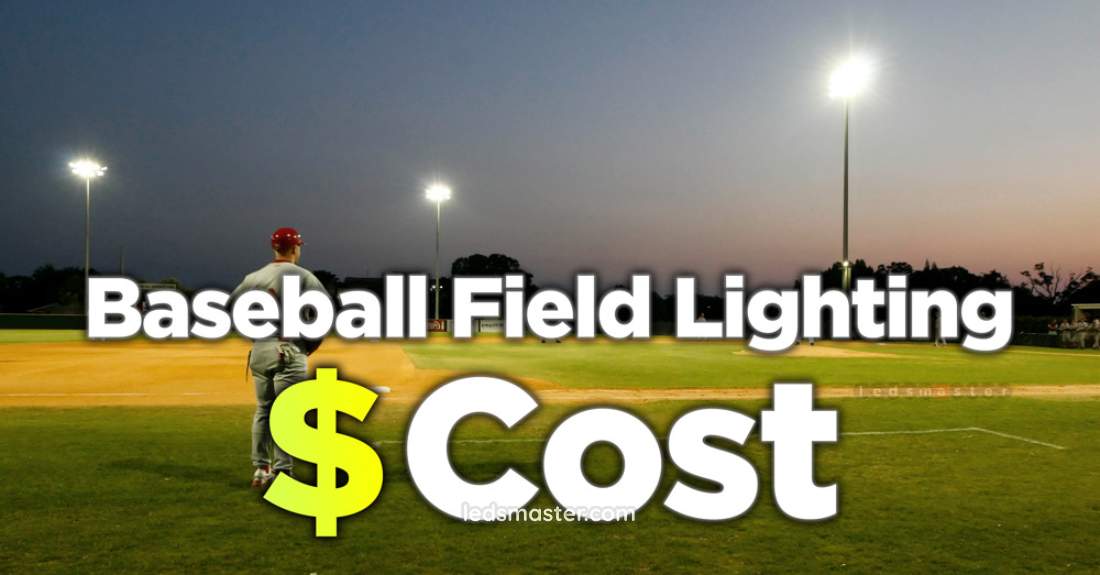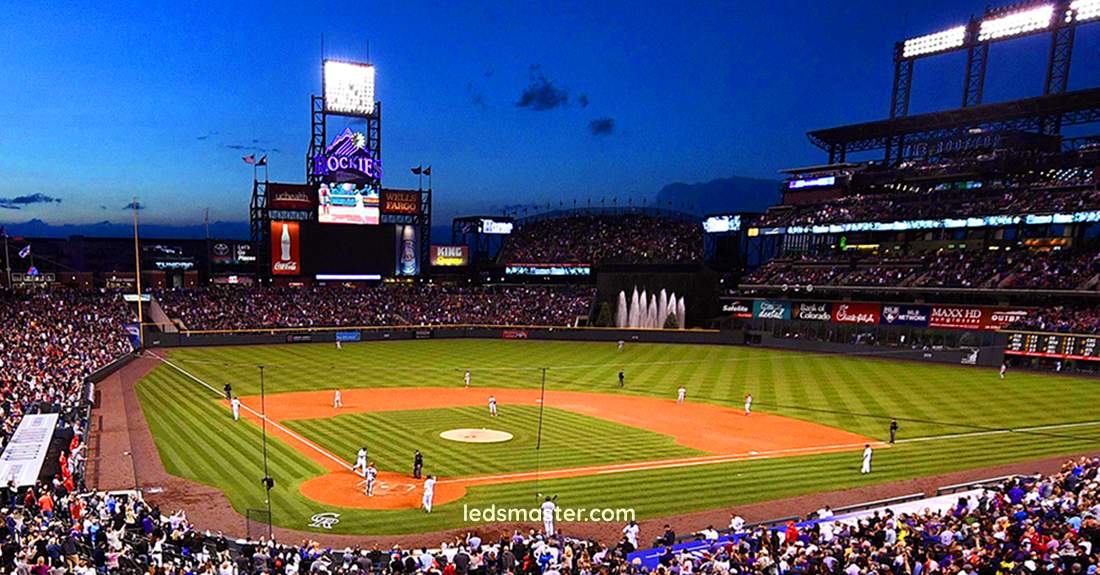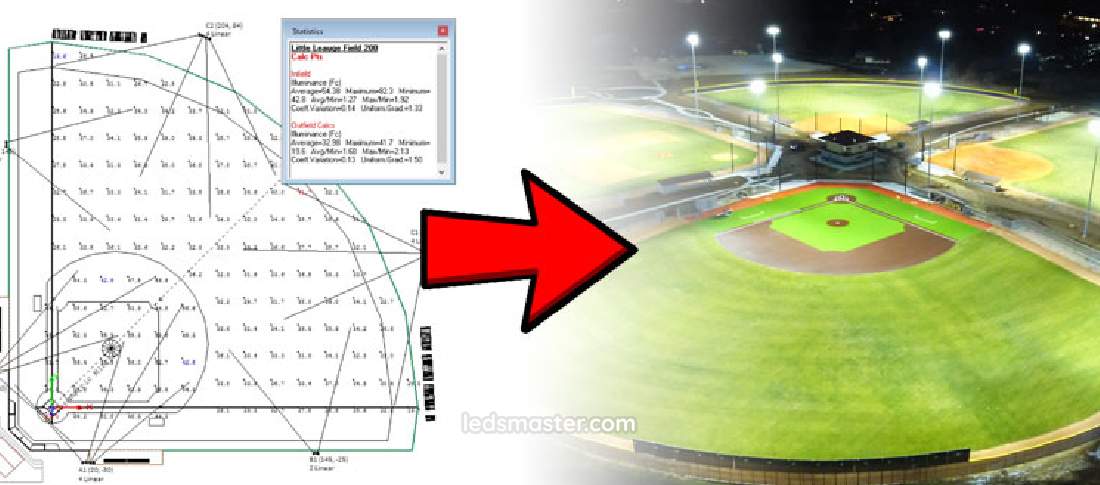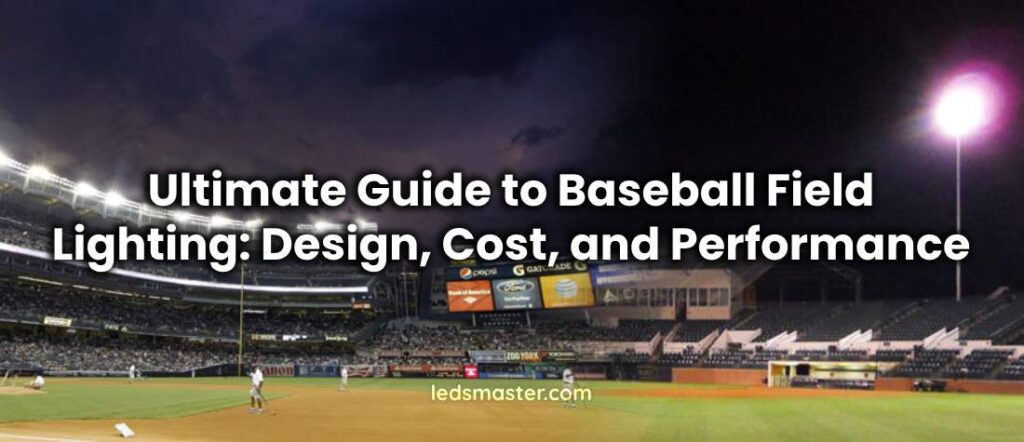Our company supplies world-class lighting for baseball fields and stadiums, suitable for events ranging from Minor to Major League Baseball (MLB). Utilizing our LED lights can save up to 80% in energy compared to traditional lighting systems like metal halide, mercury, halogen, or HPS lamps.
Table of Contents
ToggleRequirement of Baseball Stadium Lighting
Lux Level Required
For standard Little League competitions, the required illuminance is at least 540 lux for the infield and 320 lux for the outfield. Ensuring these levels is essential for proper visibility and gameplay. Lux is a measure of luminous flux per unit area and indicates how much light is present in a given area. The higher lux levels in the infield are necessary because this area sees more frequent and critical gameplay actions, such as pitching, batting, and base running. Adequate lighting in the outfield ensures that players can effectively track and catch fly balls, maintaining a high level of play and safety.
Lighting Uniformity Standard
Uniformity refers to the ratio between the minimum and maximum lux levels within the baseball field. A high uniformity ratio is crucial to avoid dim areas, which can cause visual discomfort and affect player performance. The recommended uniformity is 0.5 for the infield and 0.4 for the outfield. This means that the light distribution should be consistent, with minimal variation between the brightest and dimmest spots. Higher uniformity in the infield ensures optimal playing conditions, reducing shadows and glare that can interfere with players’ visibility. For the outfield, while slightly lower uniformity is acceptable, it still needs to be high enough to provide clear visibility for tracking balls during play.
Flicker-free Lighting
With baseballs and bats reaching speeds of 100 to 150 km/h, flicker-free lighting is essential. Flicker can cause visual strain and affect the perception of fast-moving objects, which is critical in a sport like baseball. Our LED lights support 6000 Hz high-speed cameras, ensuring no critical moments are missed during gameplay or broadcasts. Flicker-free lighting not only enhances player performance by providing a stable and consistent light source but also improves the viewing experience for spectators, both in the stadium and watching broadcasts. This is particularly important for high-speed video recording and slow-motion replays, where flicker can be highly disruptive.
CRI
The Color Rendering Index (CRI) for baseball stadiums should be at least 65. Our LED lights boast a CRI of 80, providing true color representation and enhancing the viewing experience for both players and spectators. CRI measures a light source’s ability to reveal the colors of objects accurately compared to natural light. A higher CRI means that colors appear more vivid and natural, which is important in sports lighting. Proper color rendering helps players distinguish between different objects on the field, such as the ball, bases, and uniforms. It also enhances the overall aesthetic of the game, making it more enjoyable for fans.

Factors Affecting the Baseball Field Lighting Cost
Country of Origin
The cost of baseball field lighting can vary significantly depending on the country of manufacture. Lamps produced in the US, UK, or other European countries typically come with a higher price tag. This is due to several factors, including elevated labor costs, expensive raw materials, and high factory rents. These factors contribute to the overall expense of the lighting fixtures. For instance, manufacturing costs in these regions can add substantial premiums to the final price.
In contrast, lighting fixtures manufactured in Asian countries often come at a significantly lower cost. Countries like China offer more competitive pricing due to lower labor costs, reduced material expenses, and more affordable factory rents. By sourcing lighting from reputable manufacturers in these regions, substantial savings can be achieved. The price difference between lights made in the US or Europe and those produced in Asia can range from 30% to 100%. For example, outfitting a standard baseball field with lighting purchased from the US could cost between $120,000 and $200,000. In comparison, the same setup sourced from China might only cost between $40,000 and $90,000. Opting for high-quality, cost-effective options from these regions can result in significant budgetary advantages without compromising on quality.
Type of Lighting
The type of lighting technology used in baseball fields also affects overall costs. Traditional options such as metal halide, halogen, and high-pressure sodium (HPS) floodlights are often less expensive initially compared to LED lights. However, these conventional lighting solutions come with hidden costs that can make them less economical in the long run.
Halogen lights, for instance, require a much greater number of fixtures to achieve the same level of brightness as LEDs. This is because halogen lamps have a lower lumen output per watt compared to LED lights. As a result, you may need to install ten halogen fixtures to match the brightness provided by a single LED fixture of the same wattage. Although the upfront cost of halogen lights might seem lower, the total cost of purchasing, installing, and maintaining these numerous fixtures can be comparable to or even exceed the cost of a fewer number of LED lights.
Additionally, LEDs have a significantly longer lifespan, often reaching up to 150,000 hours, compared to the shorter lifespans of traditional lighting types. This extended operational life reduces the frequency of replacements and maintenance, leading to lower long-term costs. Over time, the reduced need for replacement and maintenance of LEDs can lead to substantial savings, making them a more cost-effective choice despite their higher initial price.
Standard of Baseball Competition
The level of competition for which the baseball field is designed also impacts the lighting costs. Different standards of play necessitate varying levels of lighting sophistication and brightness. For recreational or high school baseball fields, lighting costs typically range from $30,000 to $60,000. This range reflects the lighting requirements needed for practice and local games, which are less demanding compared to professional or international standards.
For more prestigious competitions, such as international tournaments, the lighting design needs to meet higher standards. This often includes enhanced uniformity, higher brightness levels, and additional features to accommodate high-definition broadcasting. As a result, the lighting costs for these fields can range from $80,000 to $150,000. The increased investment accounts for the need for additional fixtures and more precise lighting designs to ensure that the field meets the expectations of broadcast and spectator standards.
Running Cost of Baseball Field Lighting
One of the most significant advantages of upgrading to LED lighting is the reduction in running costs. LEDs are far more energy-efficient compared to traditional halogen or metal halide systems. For example, a 30,000W LED lighting system for a baseball diamond incurs a daily operating cost of approximately $28.80, based on an average electricity rate of $0.12 per kWh. In contrast, a comparable halogen lighting system, requiring around 300,000W, would result in a daily electricity cost of about $288.

Best LED Baseball Field Lighting Considerations
Brightness
Our LED lighting solutions are available in a range of power outputs from 100 to 10,000 watts per fixture, making them versatile for various types of baseball fields, including recreational, professional, college, and league-level venues. This extensive range allows us to tailor the lighting to meet the specific needs of different field sizes and usage requirements. For recreational fields, lower wattage fixtures might suffice, while professional and college-level fields may require higher wattage options to ensure the brightness levels necessary for high-quality play and broadcasting.
The high luminous output of our LED lights ensures that the entire playing field is uniformly illuminated. This uniformity is crucial for maintaining visibility and safety during games, allowing players to see the ball clearly and perform at their best. With our expertise in high-power lighting, we can deliver optimal illumination that enhances the playing experience and meets the demands of both players and spectators.
Energy Efficiency and Longevity
LED lights are renowned for their energy efficiency, using up to 80% less energy compared to traditional metal halide lamps. This substantial reduction in energy consumption not only lowers operating costs but also makes LED lighting a more environmentally friendly option. The efficiency of LED lights translates into significant savings on electricity bills, making them a cost-effective solution in the long run.
Moreover, LEDs have an impressive lifespan of up to 150,000 hours, which is equivalent to more than 25 years of daily use, assuming an average of 6 hours of use per day. This extended lifespan significantly reduces the frequency of replacements and maintenance, further contributing to cost savings. Despite the higher initial investment required for LED fixtures, the long-term benefits of reduced energy consumption and maintenance make them a highly economical choice for lighting baseball fields.
Instant Operation
One of the key advantages of LED lights is their ability to operate instantly. Unlike traditional lighting systems, such as metal halide lamps, which require a warm-up period to reach full brightness, LEDs turn on and off immediately. This instant operation is beneficial for both everyday use and emergency situations, allowing for quick adjustments to lighting conditions.
Moreover, LEDs are compatible with motion sensors, which can enhance security and further optimize energy use. Motion sensors allow the lights to activate only when needed, reducing energy consumption and increasing the overall efficiency of the lighting system. This feature is particularly useful for fields that are not in constant use, as it ensures that lights are only on when necessary, contributing to both energy savings and improved security.
Minimizing Light Pollution
Our lighting design addresses the critical issue of light pollution by adhering to strict standards for light trespass. Light pollution occurs when artificial light spills over into areas where it is not needed, causing disruptions to the natural environment and impacting nearby residential areas. To mitigate this, our lighting systems are engineered to focus illumination precisely where it is required—on the playing field—while minimizing light spill into surrounding areas.

Conclusion
The right lighting transforms a baseball field into a stage where every pitch and swing comes to life with clarity and precision. Our cutting-edge LED solutions not only illuminate the game with exceptional brightness and uniformity but also champion energy efficiency and environmental stewardship. Imagine a field where every play is captured in stunning detail, every moment shines brightly, and players and fans alike experience the game at its best. By choosing our advanced lighting, you’re not just investing in fixtures—you’re lighting up dreams, fueling excitement, and creating a legacy of unforgettable moments on the field. Embrace the future of baseball lighting and let every game shine with brilliance and inspiration.

